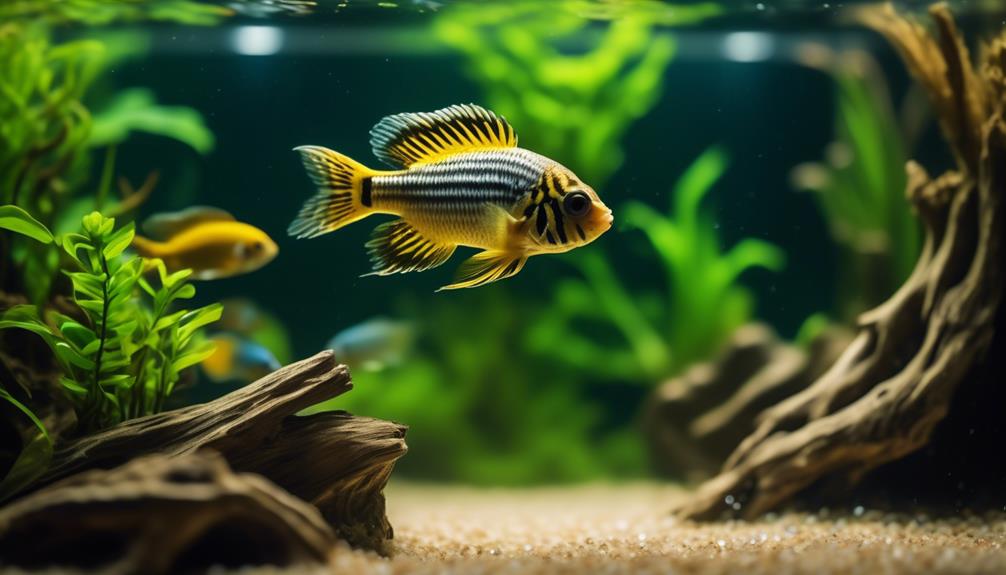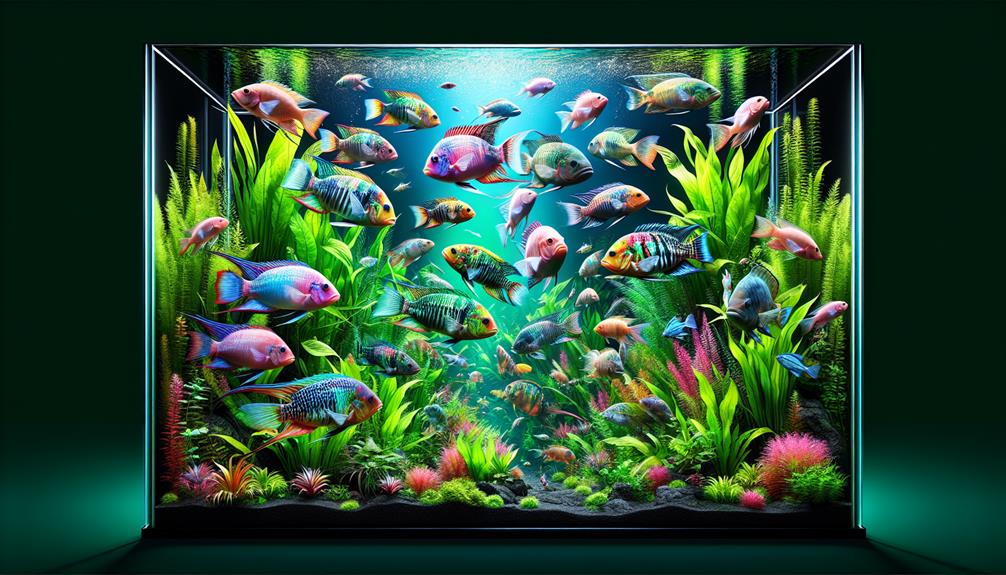Apistogramma Cichlids, originating from diverse habitats across South America, have captivated fish enthusiasts with their unique characteristics and interactive nature. With nearly 100 species to explore, these fascinating fish exhibit an array of colors, patterns, and behaviors that make them a delightful addition to any aquarium.
From the elongated dorsal fins of the males to the distinct light blue color of the umbrella dwarf cichlid, there is much to uncover about these captivating creatures. But it doesn't stop there. As we delve deeper, we will also unravel the secrets of setting up an ideal aquarium for Apistogramma Cichlids, finding compatible tank mates, and ensuring their nutritional needs are met.
Get ready to embark on a journey that will immerse you in the fascinating world of Apistogramma Cichlids and leave you wanting to discover more.
Key Takeaways
- The genus Apistogramma consists of nearly 100 species of cichlids originating from various habitats in South America.
- Male Apistogramma cichlids can grow up to 3-3.5 inches with extended dorsal fins, while females are smaller, around 2-2.5 inches.
- Apistogrammas are known for their curious and interactive behavior with their owners.
- There are different types of Apistogramma cichlids, including A. cacatuoides, A. agassizii, A. borelli, and A. trifasciata, each with unique characteristics and color variants.
Origins and Diversity of Apistogramma Cichlids
Apistogramma Cichlids, originating from various habitats across South America, exhibit a remarkable diversity with nearly 100 species within their genus. These cichlids are known for their unique breeding behaviors, which vary among different species. For example, some species practice biparental care where both the male and female actively participate in caring for the eggs and fry, while others exhibit harem breeding systems where a dominant male mates with multiple females.
Another interesting aspect of Apistogramma cichlids is the impact of water parameters on their coloration. The water's pH, hardness, and temperature can influence the intensity and vibrancy of their colors. For instance, some species, such as Apistogramma cacatuoides, display brighter colors in slightly acidic water with warmer temperatures. On the other hand, certain species, like Apistogramma agassizii, exhibit richer colors in neutral to slightly alkaline water.
Understanding and maintaining the appropriate water parameters is crucial for keeping these cichlids in optimal health and showcasing their stunning coloration.
Exploring Different Types of Apistos
The genus Apistogramma encompasses a diverse range of cichlids, each with its own unique characteristics and traits. When exploring different types of Apistos, there are several notable species to consider.
A popular choice is Apistogramma cacatuoides, also known as the cockatoo dwarf cichlid, which comes in variants such as Super Red, Double Red, Triple Red, and Orange Flash.
Another species is Apistogramma agassizii, which offers color variants like Fire Red and Gold.
Apistogramma borelli, known as the umbrella dwarf cichlid, displays a beautiful light blue coloration.
Lastly, Apistogramma trifasciata, nicknamed the three-striped dwarf cichlid, is another intriguing option.
Understanding the behavior and breeding techniques of each Apistogramma species is crucial for providing optimal care and creating successful breeding programs.
Essential Tips for Setting Up an Apistogramma Aquarium

When setting up an aquarium for Apistogramma cichlids, there are several essential factors to consider.
Maintaining water quality is crucial for the health and well-being of these cichlids.
Firstly, it is important to provide a suitable tank size of at least 20 gallons for a single or pair of apistogrammas.
The water temperature should be set between 80-82°F (27-28°C) to mimic their natural habitat.
Additionally, the pH level should be slightly acidic to neutral and the water hardness should range from 4-8 degrees GH.
To create a comfortable environment, caves, catappa leaves, hardscape, and live aquarium plants should be provided as hiding spots.
Lastly, effective methods for breeding apistogramma cichlids include providing optimal water conditions, offering nutritious food, and creating suitable spawning sites such as flat stones or flowerpots.
Finding the Perfect Tank Mates for Apistogrammas
When selecting tank mates for Apistogramma cichlids, it is important to consider species that are compatible with their behavior and habitat requirements. Here are some tips for finding the perfect tank mates for Apistogrammas:
- Choose species that inhabit different levels of the aquarium to avoid competition for territory and resources.
- Avoid keeping Apistogrammas with small creatures like dwarf shrimp and baby fish, as they may become prey.
- Betta fish should not be kept as tank mates for Apistogrammas due to their territorial behavior.
Breeding Apistogrammas can be a rewarding experience, but it is essential to provide the right conditions and care. They may be susceptible to common diseases such as ich, fin rot, and bacterial infections. Regular water changes, a balanced diet, and maintaining optimal water parameters can help prevent these issues.
A Balanced Diet for Healthy Apistogramma Cichlids

A balanced diet is crucial for maintaining the health and well-being of Apistogramma cichlids. These fish have specific dietary requirements that must be met to ensure their optimal growth and vitality.
When it comes to feeding Apistogramma cichlids, it is important to understand the importance of water parameters. These fish thrive in slightly acidic to neutral pH levels and moderate hardness.
Additionally, it is essential to consider the behavior of Apistogrammas in a community tank. They are known to be territorial and can display aggressive behavior towards other fish. Therefore, it is crucial to provide enough hiding spots and caves to create separate territories for each fish.
Frequently Asked Questions
How Long Do Apistogramma Cichlids Typically Live in Captivity?
Apistogramma cichlids typically live for 2-4 years in captivity, but with optimal care and conditions, they can live up to 5-6 years. Factors affecting lifespan include genetics, diet, water quality, and stress levels.
Can Apistogramma Cichlids Be Kept in a Community Tank With Other Fish Species?
Apistogramma cichlids can be kept in a community tank with certain fish species. Ideal tank mates include tetras, pencilfish, and hatchetfish. It is important to consider the tank size and provide enough hiding spots to minimize territorial behavior.
What Are Some Common Diseases or Health Issues That Apistogramma Cichlids May Experience?
Common diseases in Apistogramma cichlids include bacterial infections, fungal infections, and parasites. Prevention involves maintaining good water quality, providing a balanced diet, and avoiding overcrowding. Treatment may involve medications, water changes, and quarantine.
How Can You Tell the Gender of an Apistogramma Cichlid?
Determining the gender of an Apistogramma cichlid can be challenging. Males typically have longer fins and brighter colors, while females are smaller and less vibrant. Breeding behavior, such as courtship displays, can also indicate gender.
Are Apistogramma Cichlids Suitable for Beginner Fish Keepers?
Apistogramma cichlids are not recommended for beginner fish keepers due to their territorial behavior. Proper care includes providing hiding spots, a suitable tank size, and selecting compatible tank mates. Their aggression towards other fish species should be considered.
Conclusion
In conclusion, the world of Apistogramma Cichlids is a captivating one, with its diverse species and unique characteristics.
From the cockatoo dwarf cichlid to the umbrella dwarf cichlid, these fish offer a range of colors and behaviors that make them a fascinating addition to any aquarium.
By carefully setting up a suitable environment, selecting compatible tank mates, and providing a balanced diet, these remarkable aquatic creatures will thrive and continue to enchant us with their beauty and interactive nature, like a vibrant underwater tapestry.

